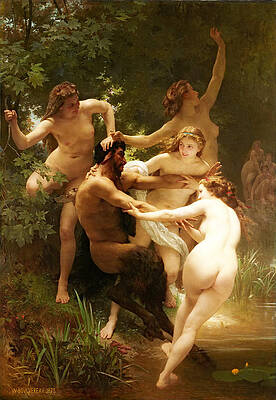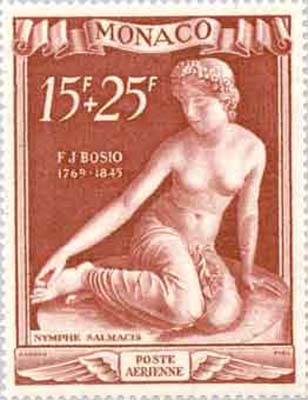.
In Greek mythology, a nymph is any member of a large class of female nature spirits, sometimes bound to a particular location or landform. Nymphs often accompanied various gods and goddesses, and were the frequent target of lusty satyrs.
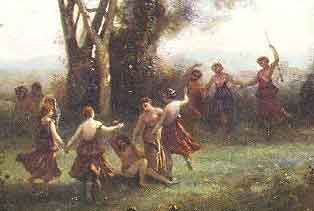
Dance of the Nymphs (Part), Jean-Baptiste-Camille Corot
They are personifications of the creative and fostering activities of nature. The Greek word νύμφη has "bride" and "veiled" among its meanings: hence, a married woman, and, in general, one of marriageable age. Others refer the word (and also Latin nubere and German Knospe) to a root expressing the idea of "swelling" (according to Hesychius, one of the meanings of νύμφη is "rose-bud"). The home of the nymphs is on mountains and in groves, by springs and rivers, in valleys and cool grottoes. They are frequently associated with the superior divinities, the huntress Artemis, the prophetic Apollo, the reveller and god of trees Dionysus, and with rustic gods such as Pan and Hermes (as the god of shepherds).
Nymph classifications
The different species of nymph were distinguished according to the different spheres of nature with which they were connected.
Land Nymphs
Alseids (glens, groves)
Auloniads (pastures)
- Dryads (forests)
- Hamadryads (trees)
- Meliae (manna-ash trees)
- Meliae (manna-ash trees)
- Hamadryads (trees)
Leimakids (meadows)
Oreads (mountains, grottoes)
Napaeae (mountain valleys, glens)
Water Nymphs
The water nymph Mareotis, Lake Mariout, seated on a stone bench. Philip Galle

The waternymph, Herbert James Draper

Oceanids (daughters of Oceanus, any water, usually salty)
Nereids (daughters of Nereus, the Mediterranean Sea)
Naiads (usually fresh water)
- Crinaeae (fountains)
- Limnades or Limnatides (lakes)
- Pegaeae (springs)
- Potameides (rivers)
Eleionomae (marshes)
Other
"Corycian Nymphs" (Classical Muses)
Lampades (Underworld, Hecate's companions)
Sphragitides, a surname of a class of prophetic nymphs on mount Cithaeron in Boeotia, where they had a grotto called sphragidion. (Plut. Aristid. 9 ; Pausanias ix. 3, in Plut. Sympos. i. 10.)

Nypmhs Mosaic
Foreign adaptations
The Greek nymphs were spirits invariably bound to places, not unlike the Latin genius loci, and the difficulty of transferring their cult may be seen in the complicated myth that brought Arethusa to Sicily. Among the Greek-educated Latin poets, the nymphs gradually absorbed into their ranks the indigenous Italian divinities of springs and streams (Juturna, Egeria, Cavmentis, Fons), while the Lymphae (originally Lumpae), Italian water-goddesses, owing to the accidental similarity of name, could be identified with the Greek Nymphae. The mythologies of classicizing Roman poets were unlikely to have affected the rites and cult of individual nymphs venerated by country people in the springs and clefts of Latium. Among the Roman literate class their sphere of influence was restricted, and they appear almost exclusively as divinities of the watery element.
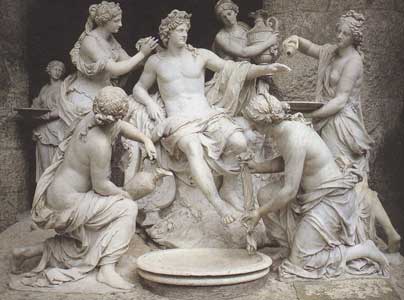
Cave of the Storm Nymphs, 1903 , Sir Edward John Poynter (English, 1836-1919) Private collection
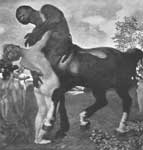
Centaur and Nymph, Franz von Stuck

Nymph and Satyr, Alexander Cabanel
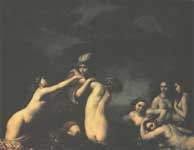
Hylas and the Nymphs, Francesco Furini

Nymphs of Nysa, Julius LeBlanc Stewart

The Cave of the Storm Nymphs , Sir Edward Poynter 1903
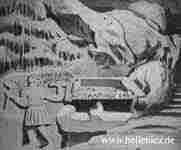
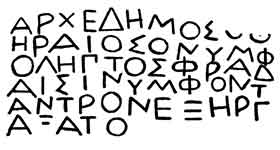
Archedemus o Theraios o Nympholyptos fradaisi Nymphon t antron exirgasato (Archedemus from Thera the nympholept decorated the cave on the advice of the nymphs) Cave in Vari
See also : Greek Mythology. Paintings, Drawings
| Ancient Greece
Science, Technology , Medicine , Warfare, , Biographies , Life , Cities/Places/Maps , Arts , Literature , Philosophy ,Olympics, Mythology , History , Images Medieval Greece / Byzantine Empire Science, Technology, Arts, , Warfare , Literature, Biographies, Icons, History Modern Greece Cities, Islands, Regions, Fauna/Flora ,Biographies , History , Warfare, Science/Technology, Literature, Music , Arts , Film/Actors , Sport , Fashion --- |
Retrieved from "http://en.wikipedia.org"
All text is available under the terms of the GNU Free Documentation License

